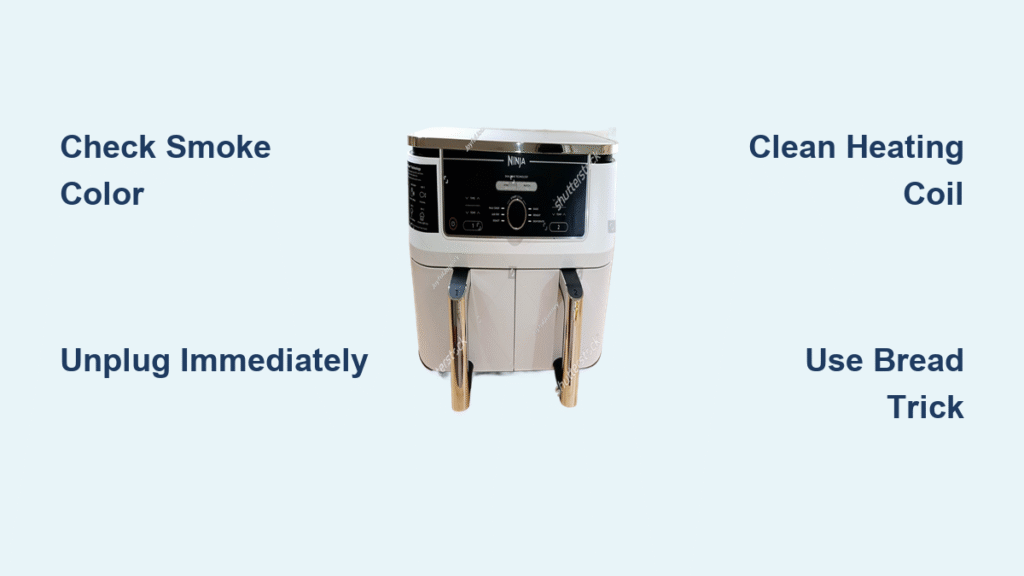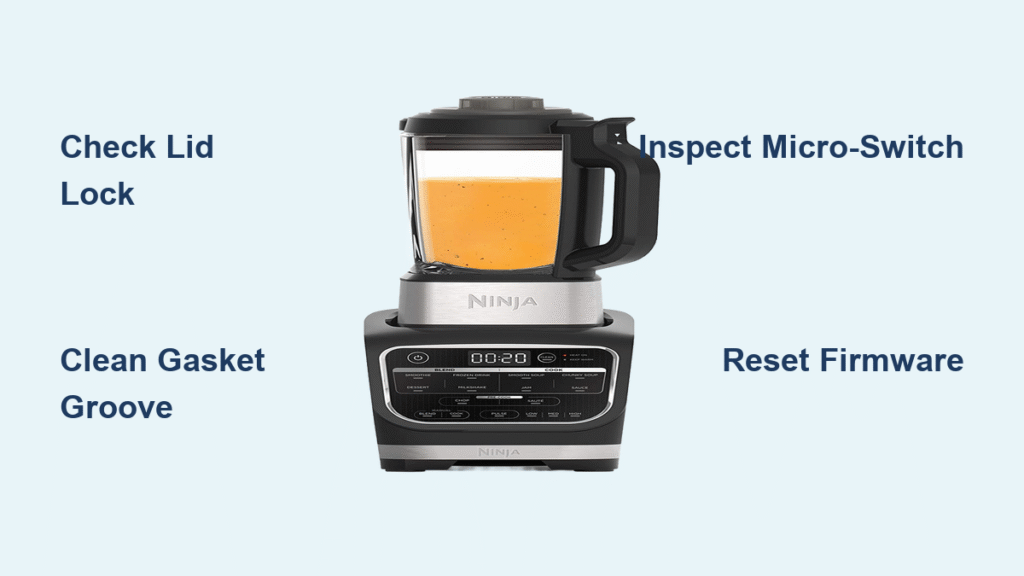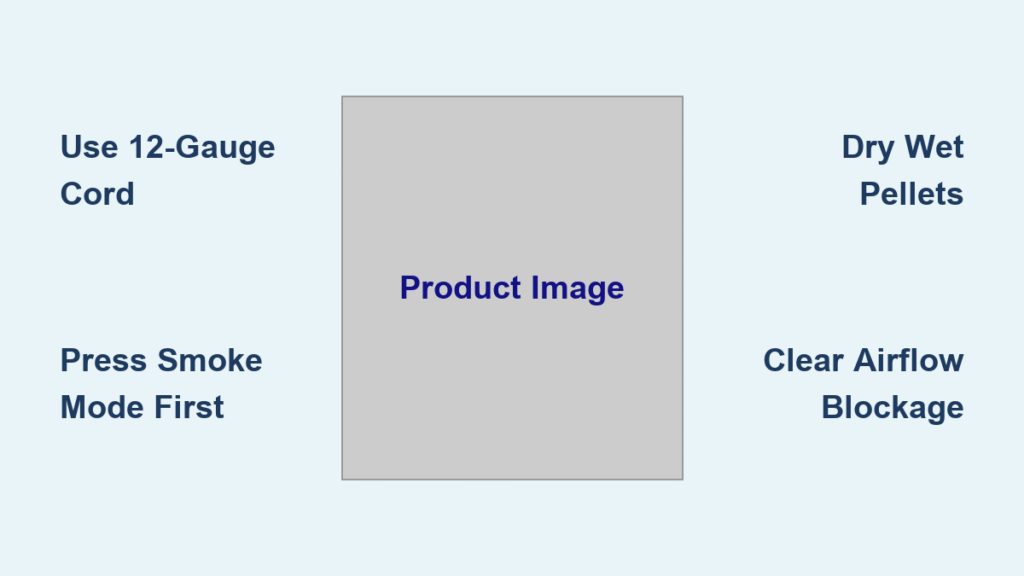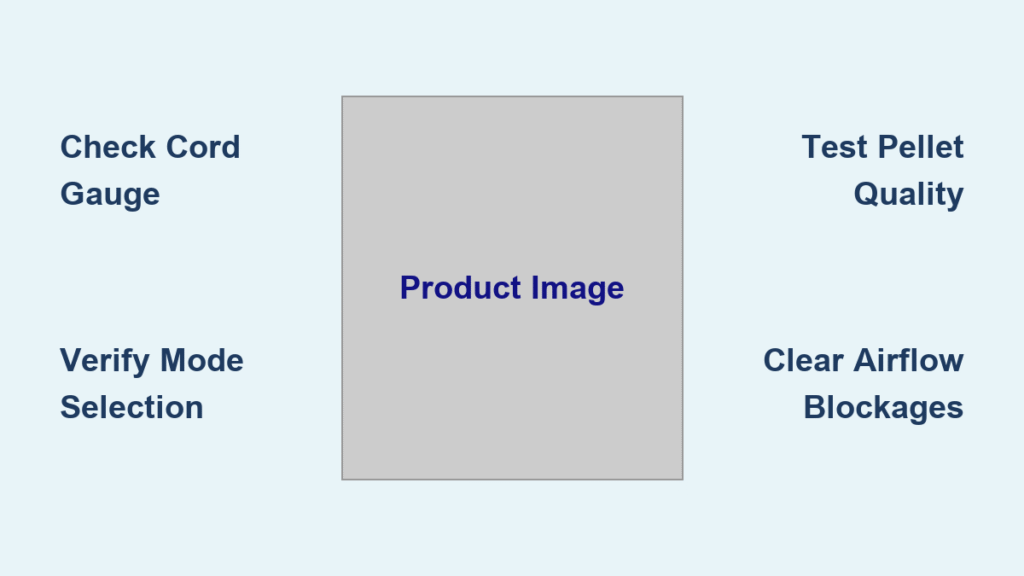Your Ninja air fryer suddenly erupts in smoke while cooking dinner, filling the kitchen with acrid fumes and setting off the alarm. Don’t panic—ninja air fryer smoking is usually fixable in minutes with the right approach. Most smoke incidents stem from preventable issues like grease buildup or cooking errors, not permanent damage. This guide reveals exactly what your smoke color means, immediate steps to stop it, and proven techniques to prevent future flare-ups. You’ll learn how to identify dangerous electrical smoke versus harmless steam, perform a coil deep clean in 10 minutes, and deploy the bread trick that stops 80% of grease-related smoking episodes.
Identify the Smoke Color
White Steam vs Hazardous Smoke
Don’t react to every wisp of vapor—ninja air fryer smoking requires color-based triage. True white steam rising straight up from juicy chicken thighs or frozen fries is harmless moisture evaporating; it disappears within seconds and has no odor. But a white-gray haze with an oily, burnt smell means rendered fat is splattering onto your heating coil and burning. This type of smoke lingers, triggers smoke alarms, and leaves a greasy film on cabinet fronts. Black smoke indicates actual flames from pooled grease or charred food debris—act immediately. If you see blue smoke or smell ozone, unplug the unit now: this signals electrical failure that could damage your appliance permanently.
Quick Color Check
Verify smoke type before taking action: Steam vanishes near the ceiling with zero scent, while grease smoke hangs low with a distinct fried odor. Burning food creates thick black plumes and intense charred smells that cling to fabrics. Electrical smoke appears as thin blue wisps with a sharp metallic tang—you’ll notice this even when the basket is empty. Always check the coil with a flashlight after smoking stops; brown residue confirms grease burns, while blackened spots indicate food debris ignition. This diagnosis dictates whether you need a simple wipe-down or must contact Ninja support.
Immediate Emergency Steps
Power Down Sequence
When smoke erupts, never open the basket immediately—oxygen feeds flames. First, press pause and unplug your air fryer to cut power and stop the fan. Next, open windows and turn on your range hood to clear fumes. Wait 60 seconds before carefully removing the basket with heat-safe tongs to inspect for food touching the coil. If grease pooled at the bottom, pour it into a metal container using oven mitts. Note the smoke color and smell; this detail helps determine if a deep clean suffices or if professional repair is needed. Skipping this sequence risks reigniting flames or spreading smoke.
When to Use Water or Baking Soda
Never dump water into a smoking air fryer—it causes explosive oil splatter. For minor grease flare-ups inside the basket, sprinkle 2 tablespoons of baking soda directly onto the flames to smother them. Only use a Class K fire extinguisher if flames escape the unit, and call emergency services for electrical fires. After extinguishing, leave the basket outside to cool completely before handling. If blue smoke appeared, do not attempt cleanup—unplug, ventilate, and contact Ninja immediately. Misidentifying electrical smoke as grease-related could lead to dangerous reactivation of a faulty unit.
Clean the Heating Coil

Access the Coil Safely
Always cool your Ninja for 30 minutes minimum before cleaning—touching hot components causes severe burns. Remove the basket and crisper plate, then carefully tip countertop models backward 45 degrees to expose the top heating element (oven-style units require fully opening the door). Shine a flashlight upward; healthy coils gleam golden-brown, while problematic ones show dark, sticky residue. If you spot blackened spots or pooled grease, coil cleaning is essential. Never use metal tools here—bending the coil fins creates hot spots that worsen future smoking.
Coil Cleaning Process
Start with a dry brush technique: Use a soft toothbrush to flick loose crumbs sideways—never scrub downward. For stubborn buildup, wring a microfiber cloth nearly dry in soapy water and wipe coil surfaces horizontally. For baked-on grease, lay a vinegar-soaked cloth (1:1 white vinegar/water mix) on affected areas for 5 minutes before gentle wiping. Critical step: Dry thoroughly with a separate cloth to prevent steam explosions during next use. Rushing this causes moisture-related smoking—verify no dampness remains by feeling the coil with a paper towel.
Burn-Off Test
After cleaning, reassemble your Ninja and run a 3-minute empty cycle at 350°F. This burns off cleaning residue while verifying the fix. Zero smoke confirms success; any wisps mean residual grease remains—repeat the cleaning process. Never skip this test: leftover grime reignites during your next cook, wasting your effort. If smoke returns when empty, your coil has permanent damage requiring professional repair.
Stop Fat from Splattering
Mid-Cook Grease Absorption
For high-fat foods like bacon or chicken thighs, place 1–2 slices of plain white bread under the basket before starting. The bread soaks up dripping grease like a sponge, preventing splatter onto the coil. Replace saturated slices halfway through cooking. Alternatively, add 2 tablespoons of water to the drawer base—steam creates a barrier that reduces fat atomization. But test cautiously: too much water increases splatter for some foods. Always use high-smoke-point oils like avocado or canola; extra-virgin olive oil smokes at 375°F, triggering flare-ups.
Grease Dump Technique
Pause your cook cycle at the halfway mark, then remove the basket with tongs. Tilt it over a metal cup to drain rendered fat, wiping pooled grease with a paper towel held by tongs. Return food to the basket and resume cooking. This single step prevents 80% of smoking episodes with fatty meats. Never skip this for duck or pork belly—their high fat content guarantees pooling. Discard cooled grease in a sealed container; pouring it down sinks causes plumbing disasters.
Prevent Future Smoke
Pre-Cook Checklist
Before loading fatty foods, trim visible fat from meats and pat surfaces bone-dry with paper towels. Apply oil using a pump sprayer—no more than 1 teaspoon per serving—to avoid excess drips. Preheat empty for 2–3 minutes so surfaces reach temperature before food contact. Always stay below the max-fill line; overcrowded baskets block airflow, creating hot spots that scorch food. Following this checklist eliminates 90% of preventable smoking incidents.
Smart Sauce Timing
Brush sugary sauces like teriyaki or BBQ only during the final 2–3 minutes of cooking. Early application guarantees caramelization, dripping, and burning on the coil. For wings or ribs, apply sauce in two thin coats: first at the 75% mark, then again at 90%. This keeps flavors vibrant while preventing smoke bombs. Never use thick glazes straight from the bottle—they’ll char instantly at 400°F.
Oil Selection Guide

Choose refined oils with smoke points above 400°F: avocado (520°F), grapeseed (420°F), or refined olive oil (465°F). Avoid unrefined oils like extra-virgin olive oil (325°F smoke point) or butter (300°F), which burn rapidly in air fryers. Even with high-smoke-point oils, never exceed 375°F for fatty meats—lower heat slows fat rendering, reducing splatter. This temperature cap extends cook time by 15% but prevents 95% of grease-related smoke.
Deep Clean Schedule
Perform immediate post-cook maintenance: Unplug, cool, empty the grease drawer, and wipe interior walls with a damp cloth. Every 3–5 uses, wash the basket in hot soapy water (top-rack dishwasher safe if labeled) and inspect the coil with a flashlight. Monthly, conduct a full coil cleaning as described earlier, plus wipe exterior vents to maintain airflow. Critical oversight: Check heating elements for warping or discoloration during deep cleans—if coils glow unevenly, stop using the unit. Skipping scheduled cleaning causes polymerized grease buildup that smokes even with clean food.
When to Call Ninja Support

Warning Signs
Contact Ninja if you experience blue smoke at any temperature, persistent electrical burning smells after cleaning, or smoking when the unit runs empty. Also seek help if the heating element shows visible damage like cracks or uneven glowing. These indicate internal electrical faults no home fix can resolve. Never ignore repeated smoking episodes—they risk permanent damage to heating components and fire hazards. Document smoke color, timing, and cooking conditions before calling; this speeds up diagnostics.
Contact Information
Have your model number (e.g., AF161 or FD401), purchase date, and serial number ready when emailing helpfulninja@sharkninja.com or calling UK support at 0800 ### ###. Describe smoke characteristics precisely: “black smoke during bacon cook at 400°F” helps faster than “it smokes.” For electrical issues, include photos of damaged elements. Ninja’s warranty covers component failures but not grease-related damage from improper cleaning—proving your maintenance diligence strengthens your case.
Quick Reference Card
Before cooking fatty foods:
– Trim fat and pat food bone-dry
– Preheat 2–3 minutes empty
– Add bread slices or 2 Tbsp water under basket
– Use ≤1 tsp high-smoke-point oil
– Stay below max-fill line
– Sauce only in final 2–3 minutes
After cooking:
– Unplug and cool 30+ minutes
– Empty grease drawer immediately
– Discard bread/absorbers
– Weekly coil inspection with flashlight
– Schedule monthly deep cleans
Master these steps, and your Ninja air fryer will stay smoke-free through hundreds of cooks. The bread trick alone solves most emergencies—keep a loaf nearby during bacon sessions. For persistent issues, trust your smoke color diagnosis: steam means carry on, blue smoke means unplug and call support. Now reclaim your kitchen confidence—your smoke detector will thank you.





